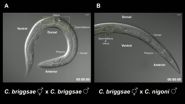(Press-News.org) Urban dwellers tend to have higher risk for cardiovascular diseases than people living in more rural locations. In a new study published in PLOS Medicine, Johanna Riha and colleagues, researchers from the University of Cambridge and the MRC/UVRI Research Unit in Uganda, have found that even within rural communities in Uganda that all lacked paved roads and running water, people living in villages with relatively more urban features—such as schools and health facilities –were more likely to have risk factors for cardiovascular diseases such as physical inactivity, lower fruit and vegetable consumption, and high body mass index, even after controlling for socioeconomic status.
The authors used data collected in 2011 to examine associations between measures of urbanicity and lifestyle risk factors. The study included 7,340 participants 13 years and older living in 25 villages in rural Uganda. They found that levels of urbanicity varied markedly across the villages, ranging from absence of educational facilities or electricity in households, to villages with a public telephone and a dispensary.
Despite the features of urbanization being relatively modest, living in more urbanized villages was associated with increased prevalence of cardiovascular disease risk factors such as physical inactivity (risk ratio [RR]: 1.19; 95% confidence interval [CI]: 1.14, 1.24), low fruit and vegetable consumption (RR: 1.17; 95% CI: 1.10, 1.23), and high body mass index (RR: 1.48; 95% CI: 1.24, 1.77), even after controlling for other factors such as socioeconomic status.
The authors state, "Our findings not only challenge the prevailing use of dichotomous urban–rural classification systems in epidemiological studies, but also indicate that even small-scale increases in urbanicity levels across rural environments are associated with a higher prevalence of unhealthy behaviours among rural residents." They acknowledge the study was limited by its cross-sectional design.
They conclude, "This is an important finding, considering that over 533 million people live in rural areas across [sub-Saharan Africa] and that any increase in cardiometabolic risk associated with the development process in these areas is likely to have an impact on population health and healthcare services…A better understanding of these associations is crucial because modification of lifestyle risk factors through changes in the physical environment, including local infrastructure, may provide a potential avenue for primary prevention of cardiometabolic diseases in rural populations."
In an accompanying Perspective, Fahad Razak and Lisa Berkman (Harvard University, Cambridge, Mass, US) discuss the study's implications. They state, "These results suggest a much more complex story than what is typically captured through well-trodden urban-rural classifications. The current dominant urban-rural dichotomy can be traced to at least the 1940s when the United Nations began reporting population statistics using this classification scheme, and is perhaps a legacy of a time when differences between urban and rural areas were much more discrete." While they say it is an important and revealing study, they also say that access to health centers, schools, and improved sanitation themselves are not likely to lead to poor health, but rather that unmeasured conditions associated with these indicators lead to increased cardiovascular risk. Furthermore, they say "80% to 85% of this rural population still have body weights in the normal to underweight range, and across all of rural Uganda prevalence of underweight exceeds overweight…Urban development and increases in social resources related to education, disease prevention, and better opportunities for work hold important promises for LMICs still confronting the costs of poverty and lack of health protection infrastructure."
INFORMATION:
Research Article
Funding: This work was sponsored by the Medical Research Council (MRC), UK (research grant numbers G0801566 and G0901213-92157) in addition to an MRC Partnership grant, ''The African Partnership for Chronic Disease Research'' strategic award (MR/K013491/1), all awarded to MSS, and by core funding from the MRC/Uganda Virus Research Institute. JR is supported by the Gates Cambridge Scholarship. SA is supported by funding from an Australian National Health and Medical Research Council/Australian National Heart Foundation Career Development Fellowship (APP1045836). SA is a researcher within a National Health and Medical Research Council Centre for Research Excellence in Obesity Policy and Food Systems (APP1041020). SA is supported by US National Institutes of Health grant titled Systems Science to Guide Whole-of-Community Childhood Obesity Interventions (1R01HL115485-01A1). The funders had no role in study design, data collection and analysis, decision to publish, or preparation of the manuscript.
Competing Interests: The authors have declared that no competing interests exist.
Citation: Riha J, Karabarinde A, Ssenyomo G, Allender S, Asiki G, et al. (2014) Urbanicity and Lifestyle Risk Factors for Cardiometabolic Diseases in Rural Uganda: A Cross-Sectional Study. PLoS Med 12(7): e1001683. doi:10.1371/journal.pmed.1001683
Author Affiliations:
University of Cambridge, UNITED KINGDOM
Wellcome Trust Sanger Institute, UNITED KINGDOM
MRC/UVRI Uganda Research Unit on AIDS, UGANDA
University of Oxford, UNITED KINGDOM
School of Health and Social Development, Deakin University, AUSTRALIA
London School of Hygiene & Tropical Medicine, UNITED KINGDOM
IN YOUR COVERAGE PLEASE USE THIS URL TO PROVIDE ACCESS TO THE FREELY AVAILABLE PAPER:
http://www.plosmedicine.org/article/info%3Adoi%2F10.1371%2Fjournal.pmed.1001683
Contact:
Manjinder Sandhu
International Health Research Group
Department of Public Health and Primary Care
University of Cambridge
+44 (0)1223 740567
ms23@sanger.ac.uk
Perspective Article
Funding: LB is supported by National Institute of Health, National Institute of Aging grant 1-P01-AG041710. The funders had no role in study design, data collection and analysis, decision to publish, or preparation of the manuscript.
Competing Interests: The authors have declared that no competing interests exist.
Citation: Razak F, Berkman L (2014) Urban Development in Sub-Saharan Africa: Bearer of Goods and Risks. PLoS Med 11(7): e1001684. doi:10.1371/journal.pmed.1001684
Author Affiliations:
Harvard University, UNITED STATES
University of Toronto, CANADA
IN YOUR COVERAGE PLEASE USE THIS URL TO PROVIDE ACCESS TO THE FREELY AVAILABLE PAPER:
http://www.plosmedicine.org/article/info%3Adoi%2F10.1371%2Fjournal.pmed.1001684
Small increases in Ugandan urbanicity tied to CVD risk factors
2014-07-29
ELSE PRESS RELEASES FROM THIS DATE:
'Killer sperm' prevents mating between worm species
2014-07-29
VIDEO:
These are time-lapse videos of Caenorhabditis hermaphrodites that were (A) mated with the same species and (B) mated with a different species. Male sperm were fluorescently labeled and appear as...
Click here for more information.
The classic definition of a biological species is the ability to breed within its group, and the inability to breed outside it. For instance, breeding a horse and a donkey may result in a live mule offspring, but mules are nearly always sterile ...
Urbanization of rural Africa associated with increased risk of heart disease and diabetes
2014-07-29
The increasing urbanisation of rural areas in sub-Saharan Africa could lead to an explosion in incidences of heart disease and diabetes, according to a new study carried out in Uganda which found that even small changes towards more urban lifestyles was associated with increased risk of cardiovascular and metabolic diseases.
Over 530 million people live in rural areas of sub-Saharan Africa, where rates of cardiovascular and metabolic diseases tend to be much lower than in urban areas. However, many of these areas are becoming increasingly urbanised, with people living ...
Mysterious molecules in space
2014-07-29
WASHINGTON D.C., July 29, 2014 – Over the vast, empty reaches of interstellar space, countless small molecules tumble quietly though the cold vacuum. Forged in the fusion furnaces of ancient stars and ejected into space when those stars exploded, these lonely molecules account for a significant amount of all the carbon, hydrogen, silicon and other atoms in the universe. In fact, some 20 percent of all the carbon in the universe is thought to exist as some form of interstellar molecule.
Many astronomers hypothesize that these interstellar molecules are also responsible ...
This week from AGU: Cell tower rain gauges, lightning channels, North Sea storm surge
2014-07-29
This Week From AGU: Cell phone tower rain gauges, lightning channels, North Sea storm surge
From AGU's blogs: Dropped cell phone calls become rain gauges in West Africa
A shaky cell phone connection during a rainstorm can be an annoying nuisance. But now scientists are showing that these weakened signals can be used to monitor rainfall in West Africa, a technique that could help cities in the region better prepare for floods and combat weather-related diseases, according to a new study accepted for publication in Geophysical Research Letters, a journal of the American ...
Penn team makes cancer glow to improve surgical outcomes
2014-07-29
The best way to cure most cases of cancer is to surgically remove the tumor. The Achilles heel of this approach, however, is that the surgeon may fail to extract the entire tumor, leading to a local recurrence.
With a new technique, researchers at the University of Pennsylvania have established a new strategy to help surgeons see the entire tumor in the patient, increasing the likelihood of a positive outcome. This approach relies on an injectable dye that accumulates in cancerous tissues much more so than normal tissues. When the surgeon shines an infrared light on the ...
Huge waves measured for first time in Arctic Ocean
2014-07-29
As the climate warms and sea ice retreats, the North is changing. An ice-covered expanse now has a season of increasingly open water which is predicted to extend across the whole Arctic Ocean before the middle of this century. Storms thus have the potential to create Arctic swell – huge waves that could add a new and unpredictable element to the region.
A University of Washington researcher made the first study of waves in the middle of the Arctic Ocean, and detected house-sized waves during a September 2012 storm. The results were recently published in Geophysical Research ...
Underwater elephants
2014-07-29
In the high-tech world of science, researchers sometimes need to get back to basics. UC Santa Barbara's Douglas McCauley did just that to study the impacts of the bumphead parrotfish (Bolbometopon muricatum) on coral reef ecosystems at two remote locations in the central Pacific Ocean.
Using direct observation, animal tracking and computer simulation, McCauley, an assistant professor in the Department of Ecology, Evolution and Marine Biology, and his colleagues sought to understand whether the world's largest parrotfish is necessary for positively shaping the structure ...
Vision-correcting display makes reading glasses so yesterday
2014-07-29
BERKELEY — What if computer screens had glasses instead of the people staring at the monitors? That concept is not too far afield from technology being developed by computer and vision scientists at the University of California, Berkeley.
The researchers are developing computer algorithms to compensate for an individual's visual impairment, and creating vision-correcting displays that enable users to see text and images clearly without wearing eyeglasses or contact lenses. The technology could potentially help hundreds of millions of people who currently need corrective ...
Researchers take steps toward development of a vaccine against tick-transmitted disease
2014-07-29
Virginia Commonwealth University School of Medicine researchers have made an important advancement toward developing a vaccine against the debilitating and potentially deadly tick-transmitted disease, human granulocytic anaplasmosis (HGA).
During the past several years, experts have seen a steady rise in the incidence of human infections caused by tick-transmitted bacterial pathogens — making the need for a vaccine critical. Successful vaccine development hinges on knowing what to target to prevent disease, and the VCU team has identified three such proteins on the surface ...
Brainwaves can predict audience reaction for television programming
2014-07-29
Media and marketing experts have long sought a reliable method of forecasting responses from the general population to future products and messages. According to a study conducted at the City College of New York (CCNY) in partnership with Georgia Tech, it appears that the brain responses of just a few individuals are a remarkably strong predictor.
By analyzing the brainwaves of 16 individuals as they watched mainstream television content, researchers were able to accurately predict the preferences of large TV audiences, up to 90 percent in the case of Super Bowl commercials. ...




